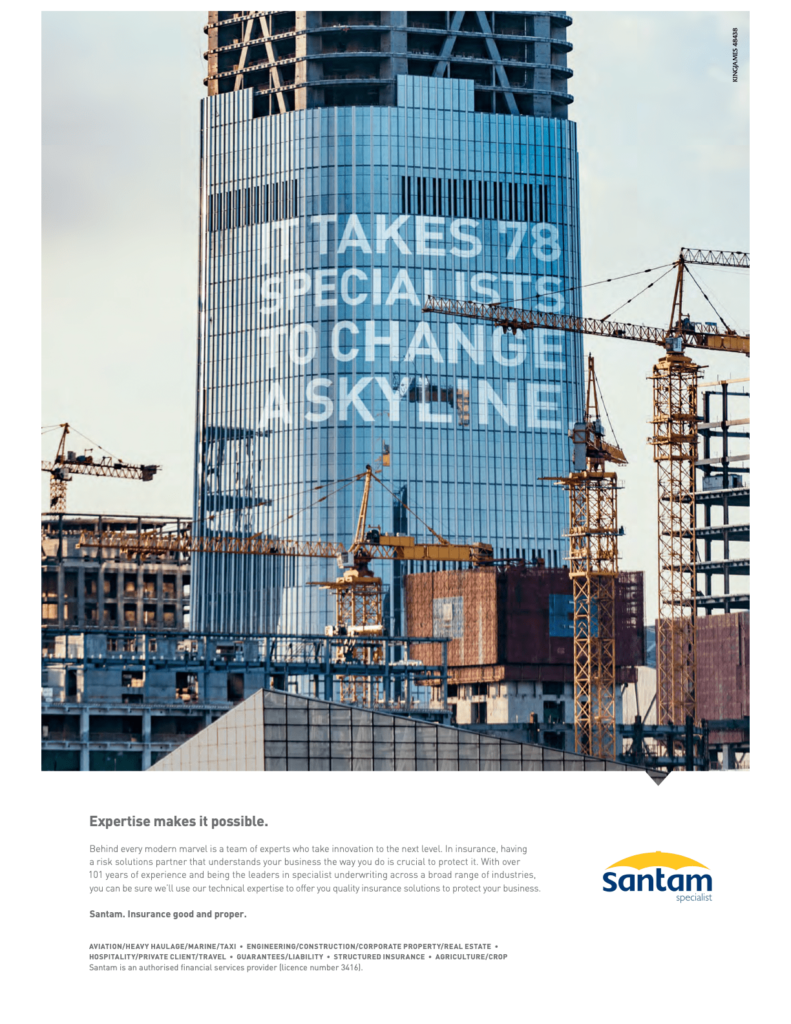Andrew Coutts: Head Intermediated Distribution at Santam

What’s the next black swan likely to be? A black swan is a potentially dire unexpected event – the pandemic being a perfect example. An Eskom grid failure could be next. Or another devastating drought? A massive cyber-attack? The emerging risk landscape is evolving fast. The financial services industry is needing to change tactics to keep abreast with the pace of change.
In the past, risk transfer was the name of the game. Now, intermediaries need to act as real-time risk advisers, proactively helping clients to forecast and mitigate threats. Brokers and insurers must be futurologists – custodians of the future. 2021 was a year of doing. A year of bolstering resilience in the face of a future we’re only now beginning to grasp. 2022 will be a continuation of that journey.
Tricky times offer opportunities for innovation
The question is how to ensure the financial services industry is set up to withstand the challenges ahead. The pandemic brought a flash of change and complexity that was not an anomaly, but part of a larger global trend. Risks are on the rise: shifting weather patterns are catalysing extreme flooding or drought; there are deteriorating water and power infrastructure; and increasing instances of cybercrime, to name a few.
Other challenges include higher than anticipated losses in certain lines, an industry that’s still mostly dependent on face-to-face interaction for growth, a decrease in new business, a rise in fraud and cyber risk, and shifts in client expectations.
As emerging risk advisers, intermediaries need to explore likely future scenarios for clients and advise on relevant, nuanced insurance offerings accordingly. A move to a proactive risk advisory model is key.
Making the move to be risk advisers
At Santam, we believe a natural next step is for brokers to monetise their advice offerings, so they can embrace the role of risk adviser without being solely reliant on product sales. The days of intermediaries simply selling generic products are over. With the escalation of risk exposure, plus affordability issues and cheaper alternative channel solutions, product-push-only business models are outdated.
Remaining relevant is dependent on shifting focus to mapping out new risks and offering bespoke solutions to these. That means client-centricity will be core. Its imperative intermediaries are armed with the tools and knowledge to know what clients need – now and in the future.
Risk prevention was already a focus in 2021 and will continue to be so in 2022. During the pandemic, many intermediaries became champions for their clients through strong claims advocacy and a proactive restructuring of policies to cut costs and ensure the appropriateness of cover. Next, they need to push their client relationships further. This means becoming an everyday adviser; unlocking the power of real-time, personalised data; adopting a nimbler, more responsive approach to clients’ needs, and managing every touchpoint of the client experience.

Expertise makes it possible
Behind every modern marvel is a team of experts who take innovation to the next level. In insurance, having
a risk solutions partner that understands your business the way you do is crucial to protect it.
Santam is an authorised financial services provider (licence number 3416).
Spelling out policy exclusions
Policy wording is notoriously tricky to understand. Intermediaries will need to continue to focus on building expert product knowledge and keeping a thorough record of advice. Clients must know what’s covered by a product and – equally, if not more importantly – what is not. Policies need to be explained in detail and a record of the conversation must be kept.
Cybercrime is a prime example of the need for this. Should a client get hacked and have no cyber cover, they may try to claim against another part of their policy, which could create a resource-draining claims dispute. With cybercrime becoming so pervasive, it’s imperative that brokers keep it top of mind as a major risk to mitigate.
Becoming digitally led entities
In 2021, brokers also entrenched more digital solutions into their businesses. The demands of regulatory change and the pressures of the pandemic may prompt more consolidation within the industry in 2022. The upshot of this is that it provides the scale necessary for brokers to invest in technology – an imperative in the digital age. Digital marketing and online multi-quote technologies offer a wealth of relatively untapped opportunities.
Entrenching digital ways of working should form part of a ‘no regret’ culture that empowers brokers to make iterative step-changes. Brokerages need to consider agile ways of working across cross-functional teams, with more automation and AI when appropriate. Crucially, granular client insights will allow brokers to offer hyper-personalised advice and relevant product pushes.
Conclusion
To future-proof their businesses, brokers need to focus on becoming risk advisers with strong product knowledge and immaculate record-keeping. A broker can’t be an expert on everything, so we’re likely to see more industry specialisation in 2022. Insurers and brokers will need to continue to work closely together to ensure a broader selection of relevant cover options at different price points. Client education will also be top of mind as the move to a risk prevention model is made.
Santam is committed to working alongside our broker partners to provide future-fit products, advice, and support. Right now, resilience is key. And brokers that offer clients value through relevant advice will win in the long term. Right now, it’s about making incremental changes to improve existing offerings for current clients, while plotting evolutionary, exponential changes to create new offerings that meet the demands of the client of the future.

